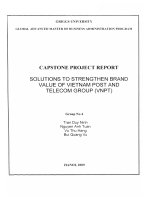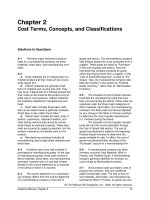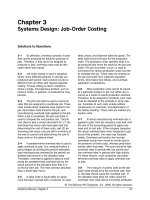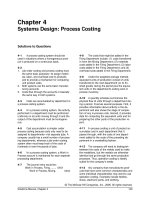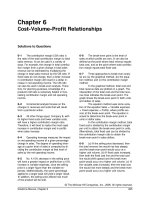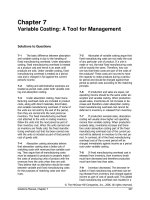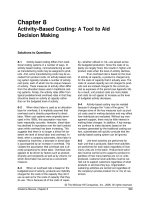Solutions to question managerial accounting ch12 segment reporting and decentralization
Bạn đang xem bản rút gọn của tài liệu. Xem và tải ngay bản đầy đủ của tài liệu tại đây (215.07 KB, 68 trang )
Chapter 12
Segment Reporting and Decentralization
Solutions to Questions
12-1 In a decentralized organization, decision-making authority isn’t confined to a few top
executives, but rather is spread throughout the
organization with lower-level managers and
other employees empowered to make decisions.
12-2 The benefits of decentralization include:
(1) freeing top managers to focus on strategy,
higher-level decision making, and coordinating
activity; (2) improving operational decision making, since lower-level managers often have better information about local conditions; (3) enabling quicker response to customer needs; (4)
training lower-level managers to take on greater
responsibility; and (5) providing greater motivation and job satisfaction for lower-level managers.
12-3 A cost center manager has control over
cost, but not revenue or investment funds. A
profit center manager has control over both cost
and revenue. An investment center manager has
control over cost and revenue and investment
funds.
12-4 A segment is any part or activity of an
organization about which a manager seeks cost,
revenue, or profit data. Examples of segments
include departments, operations, sales territories, divisions, product lines, and so forth.
12-5 Under the contribution approach, costs
are assigned to a segment if and only if the
costs are traceable to the segment. Common
costs are not allocated to segments under the
contribution approach.
12-6 A traceable cost of a segment is a cost
that arises specifically because of the existence
of that segment. If the segment were eliminated, the cost would disappear. A common
cost, by contrast, is a cost that supports more
than one segment, but is not traceable in whole
or in part to any one of the segments. If the
departments of a company are treated as segments, then examples of the traceable costs of a
department would include the salary of the department’s supervisor, depreciation of machines
used exclusively by the department, and the
costs of supplies used by the department. Examples of common costs would include the salary of the general counsel of the entire company, the lease cost of the headquarters building, corporate image advertising, and periodic
depreciation of machines shared by several departments.
12-7 The contribution margin is the difference
between sales revenue and variable expenses.
The segment margin is the amount remaining
after deducting traceable fixed expenses from
the contribution margin. The contribution margin
is useful as a planning tool for many decisions,
including those in which fixed costs don’t
change. The segment margin is useful in assessing the overall profitability of a segment.
12-8 If common costs were allocated to segments, then the costs of segments would be
overstated and their margins would be understated. As a consequence, some segments may
appear to be unprofitable and managers may be
tempted to eliminate them. If a segment were
eliminated because of the existence of arbitrarily
allocated common costs, the overall profit of the
© The McGraw-Hill Companies, Inc., 2006. All rights reserved.
Solutions Manual, Chapter 12
713
company would decline by the amount of the
segment margin because the common cost
would remain. The common cost that had been
allocated to the segment would then be reallocated to the remaining segments—making them
appear less profitable.
12-9 There are often limits to how far down
an organization a cost can be traced. Therefore,
costs that are traceable to a segment may become common as that segment is divided into
smaller segment units. For example, the costs of
national TV and print advertising might be
traceable to a product line, but be a common
cost of the geographic sales territories in which
that product line is sold.
12-10 Margin refers to the ratio of net operating income to total sales. Turnover refers to the
ratio of total sales to average operating assets.
The product of the two numbers is the ROI.
12-11 Residual income is the net operating
income an investment center earns above the
company’s minimum required rate of return on
operating assets.
12-12 If ROI is used to evaluate performance,
a manager of an investment center may reject a
profitable investment opportunity whose rate of
return exceeds the company’s required rate of
return but whose rate of return is less than the
investment center’s current ROI. The residual
income approach overcomes this problem since
any project whose rate of return exceeds the
company’s minimum required rate of return will
result in an increase in residual income.
12-13 A transfer price is the price charged for
a transfer of goods or services between segments of the same organization, such as two
departments or divisions. Transfer prices are
needed for performance evaluation purposes.
The selling unit gets credit for the transfer price
and the buying unit must deduct the transfer
price as an expense.
12-14 If the selling division has idle capacity,
any transfer price above the variable cost of
producing an item for transfer will generate
some additional profit.
12-15 If the selling division has no idle capacity, then the transfer price would have to cover
at least the division’s variable cost plus the contribution margin on lost sales.
12-16 Cost-based transfer prices are widely
used because they are easily understood and
convenient to use. Their disadvantages are that
they can lead to poor decisions regarding
whether transfers should be made, they provide
little incentive for cost control, and the selling
division makes no profit.
12-17 Using the market price as the transfer
price can lead to incorrect decisions. When the
selling division has idle capacity, the cost to the
company of the transfer is just the variable cost
of the item transferred. However, if the market
price is used as the transfer price, the buying
division regards the market price as the cost. If
the market price exceeds the variable cost
(which will ordinarily happen), managers in the
buying division will make less than optimal pricing and other decisions concerning the product.
© The McGraw-Hill Companies, Inc., 2006. All rights reserved.
714
Managerial Accounting, 11th Edition
Exercise 12-1 (15 minutes)
Total
Amount %
Sales* ......................... $300,000 100
Less variable expenses.. 183,000 61
Contribution margin ...... 117,000 39
Less traceable fixed
expenses...................
66,000 22
Product line segment
margin ......................
51,000 17
Less common fixed
expenses not trace33,000 11
able to products.........
Net operating income.... $ 18,000
6
Weedban
%
Amount
$90,000 100
36,000 40
54,000 60
Greengrow
Amount %
$210,000 100
147,000 70
63,000 30
45,000
50
21,000
10
$ 9,000
10
$ 42,000
20
* Weedban: 15,000 units × $6 per unit = $90,000.
Greengrow: 28,000 units × $7.50 per unit = $210,000.
Variable expenses are computed in the same way.
© The McGraw-Hill Companies, Inc., 2006. All rights reserved.
Solutions Manual, Chapter 12
715
Exercise 12-2 (10 minutes)
1.
Margin =
=
2.
Net operating income
Sales
$600,000
= 8%
$7,500,000
Turnover =
=
Sales
Average operating assets
$7,500,000
= 1.5
$5,000,000
3. ROI = Margin × Turnover
= 8% × 1.5 = 12%
© The McGraw-Hill Companies, Inc., 2006. All rights reserved.
716
Managerial Accounting, 11th Edition
Exercise 12-3 (10 minutes)
Average operating assets ........................
£2,800,000
Net operating income..............................
Minimum required return:
18% × average operating assets...........
Residual income .....................................
£600,000
£504,000
£ 96,000
© The McGraw-Hill Companies, Inc., 2006. All rights reserved.
Solutions Manual, Chapter 12
717
Exercise 12-4 (30 minutes)
1. a. The lowest acceptable transfer price from the perspective of the selling division is given by the following formula:
Total contribution margin
on lost sales
Transfer price ≥ Variable cost +
per unit
Number of units transferred
Since there is enough idle capacity to fill the entire order from the HiFi Division, no outside sales are lost. And since the variable cost per
unit is $42, the lowest acceptable transfer price as far as the selling
division is concerned is also $42.
Transfer price ≥ $42 +
$0
= $42
5,000
b. The Hi-Fi division can buy a similar speaker from an outside supplier
for $57. Therefore, the Hi-Fi Division would be unwilling to pay more
than $57 per speaker.
Transfer price ≤ Cost of buying from outside supplier = $57
c. Combining the requirements of both the selling division and the buying division, the acceptable range of transfer prices in this situation
is:
$42 ≤ Transfer price ≤ $57
Assuming that the managers understand their own businesses and
that they are cooperative, they should be able to agree on a transfer
price within this range and the transfer should take place.
d. From the standpoint of the entire company, the transfer should take
place. The cost of the speakers transferred is only $42 and the company saves the $57 cost of the speakers purchased from the outside
supplier.
© The McGraw-Hill Companies, Inc., 2006. All rights reserved.
718
Managerial Accounting, 11th Edition
Exercise 12-4 (continued)
2. a. Each of the 5,000 units transferred to the Hi-Fi Division must displace
a sale to an outsider at a price of $60. Therefore, the selling division
would demand a transfer price of at least $60. This can also be computed using the formula for the lowest acceptable transfer price as
follows:
Transfer price ≥ $42 +
($60 - $42)
× 5,000
5,000
= $42 + ($60 - $42) = $60
b. As before, the Hi-Fi Division would be unwilling to pay more than $57
per speaker.
c. The requirements of the selling and buying divisions in this instance
are incompatible. The selling division must have a price of at least
$60 whereas the buying division will not pay more than $57. An
agreement to transfer the speakers is extremely unlikely.
d. From the standpoint of the entire company, the transfer should not
take place. By transferring a speaker internally, the company gives up
revenue of $60 and saves $57, for a loss of $3.
© The McGraw-Hill Companies, Inc., 2006. All rights reserved.
Solutions Manual, Chapter 12
719
Exercise 12-5 (20 minutes)
1.
Sales ...............................
Less variable expenses......
Contribution margin ..........
Less traceable fixed expenses ..........................
Divisional segment margin................................
Less common fixed expenses not traceable to
divisions* ......................
Net operating income
(loss) ............................
Total Company
Amount
%
$1,000,000 100.0
390,000 39.0
610,000 61.0
535,000
53.5
75,000
7.5
90,000
9.0
$ (15,000)
East
Amount
%
160,000
64
$250,000 100
130,000 52
120,000 48
Division
Central
Amount %
$400,000 100
120,000 30
280,000 70
200,000
$(40,000) (16) $ 80,000
50
West
Amount %
$350,000 100
140,000 40
210,000 60
175,000
50
20 $ 35,000
10
(1.5)
*$625,000 – $535,000 = $90,000.
2. Incremental sales ($350,000 × 20%) .........
Contribution margin ratio ...........................
Incremental contribution margin ................
Less incremental advertising expense .........
Incremental net operating income ..............
$70,000
× 60%
42,000
15,000
$27,000
Yes, the advertising program should be initiated.
© The McGraw-Hill Companies, Inc., 2006. All rights reserved.
720
Managerial Accounting, 11th Edition
Exercise 12-6 (20 minutes)
1.
Margin =
Net operating income
Sales
=
$150,000
= 5.00%
$3,000,000
Turnover =
=
Sales
Average operating assets
$3,000,000
= 4.00
$750,000
ROI = Margin × Turnover
= 5% × 4 = 20%
2.
Margin =
Net operating income
Sales
=
$150,000(1.00 + 2.00)
$3,000,000(1.00 + 0.50)
=
$450,000
= 10.00%
$4,500,000
Turnover =
Sales
Average operating assets
=
$3,000,000 (1.00 + 0.50)
$750,000
=
$4,500,000
= 6.00
$750,000
ROI = Margin × Turnover
= 10% × 6 = 60%
© The McGraw-Hill Companies, Inc., 2006. All rights reserved.
Solutions Manual, Chapter 12
721
Exercise 12-6 (continued)
3.
Margin =
Net operating income
Sales
=
$150,000 + $200,000
$3,000,000 + $1,000,000
=
$350,000
= 8.75%
$4,000,000
Turnover =
Sales
Average operating assets
=
$3,000,000 + $1,000,000
$750,000 + $250,000
=
$4,000,000
= 4.00
$1,000,000
ROI = Margin × Turnover
= 8.75% × 4 = 35%
© The McGraw-Hill Companies, Inc., 2006. All rights reserved.
722
Managerial Accounting, 11th Edition
Exercise 12-7 (20 minutes)
1. $75,000 × 40% CM ratio = $30,000 increased contribution margin in
Minneapolis. Since the fixed costs in the office and in the company as a
whole will not change, the entire $30,000 would result in increased net
operating income for the company.
It is not correct to multiply the $75,000 increase in sales by Minneapolis’
24% segment margin ratio. This approach assumes that the segment’s
traceable fixed expenses increase in proportion to sales, but if they did,
they would not be fixed.
2. a. The segmented income statement follows:
Total Company
Amount
%
Sales .......................... $500,000 100.0
Less variable expenses ..................... 240,000 48.0
Contribution margin ..... 260,000 52.0
Less traceable fixed
expenses.................. 126,000 25.2
Office segment margin........................... 134,000 26.8
Less common fixed
expenses not trace63,000 12.6
able to segments ......
Net operating income... $ 71,000 14.2
Segments
Chicago
Minneapolis
Amount %
Amount %
$200,000 100
$300,000 100
60,000
140,000
30
70
180,000
120,000
60
40
78,000
39
48,000
16
31 $ 72,000
24
$ 62,000
b. The segment margin ratio rises and falls as sales rise and fall due to
the presence of fixed costs. The fixed costs are spread over a larger
base as sales increase.
In contrast to the segment ratio, the contribution margin ratio is stable so long as there is no change in either the variable expenses or
the selling price per unit of service.
© The McGraw-Hill Companies, Inc., 2006. All rights reserved.
Solutions Manual, Chapter 12
723
Exercise 12-8 (15 minutes)
1. The company should focus its campaign on the Dental market. The
computations are:
Medical
Dental
Increased sales ............................................. $40,000 $35,000
Market CM ratio............................................. × 36% × 48%
Incremental contribution margin..................... 14,400 16,800
Less cost of the campaign..............................
5,000
5,000
Increased segment margin and net operating
income for the company as a whole ............. $ 9,400 $11,800
2. The $48,000 in traceable fixed expenses in Exercise 12-7 is now partly
traceable and partly common. When we segment Minneapolis by market, only $33,000 remains a traceable fixed expense. This amount
represents costs such as advertising and salaries of individuals that arise
because of the existence of the Medical and Dental markets. The remaining $15,000 ($48,000 – $33,000) becomes a common cost when
Minneapolis is segmented by market. This amount would include costs
such as the salary of the manager of the Minneapolis office that could
not be avoided by eliminating either of the two market segments.
© The McGraw-Hill Companies, Inc., 2006. All rights reserved.
724
Managerial Accounting, 11th Edition
Exercise 12-9 (30 minutes)
1.
Margin =
=
Turnover =
=
Net operating income
Sales
$70,000
= 5%
$1,400,000
Sales
Average operating assets
$1,400,000
= 4.00
$350,000
ROI = Margin × Turnover
= 5% × 4 = 20%
2.
Margin =
Net operating income
Sales
=
$70,000 + $18,200
$1,400,000 + $70,000
=
$88,200
= 6%
$1,470,000
Turnover =
Sales
Average operating assets
=
$1,400,000 + $70,000
$350,000
=
$1,470,000
= 4.2
$350,000
ROI = Margin × Turnover
= 6% × 4.20 = 25.2%
© The McGraw-Hill Companies, Inc., 2006. All rights reserved.
Solutions Manual, Chapter 12
725
Exercise 12-9 (continued)
3.
Margin =
Net operating income
Sales
=
$70,000 + $14,000
$1,400,000
=
$84,000
= 6%
$1,400,000
Turnover =
=
Sales
Average operating assets
$1,400,000
=4
$350,000
ROI = Margin × Turnover
= 6% × 4 = 24%
4.
Margin =
=
Turnover =
Net operating income
Sales
$70,000
= 5%
$1,400,000
Sales
Average operating assets
=
$1,400,000
$350,000 - $70,000
=
$1,400,000
=5
$280,000
ROI = Margin × Turnover
= 5% × 5 = 25%
© The McGraw-Hill Companies, Inc., 2006. All rights reserved.
726
Managerial Accounting, 11th Edition
Exercise 12-10 (20 minutes)
1.
(a)
Sales
$2,500,000
$2,600,000
$2,700,000
$2,800,000
$2,900,000
$3,000,000
(b)
(c)
Net
Average
Operating Operating
Income*
Assets
$475,000
$500,000
$525,000
$550,000
$575,000
$600,000
$1,000,000
$1,000,000
$1,000,000
$1,000,000
$1,000,000
$1,000,000
ROI
(b) ÷ (c)
47.5%
50.0%
52.5%
55.0%
57.5%
60.0%
*Sales × Contribution Margin Ratio – Fixed Expenses
2. The ROI increases by 2.5% for each $100,000 increase in sales. This
happens because each $100,000 increase in sales brings in an additional
profit of $25,000. When this additional profit is divided by the average
operating assets of $1,000,000, the result is an increase in the company’s ROI of 2.5%.
Increase in sales .................................................... $100,000
Contribution margin ratio........................................
25%
Increase in contribution margin and net operating
income (a) × (b) .................................................
$25,000
Average operating assets........................................ $1,000,000
Increase in return on investment (c) ÷ (d) ...............
2.5%
(a)
(b)
(c)
(d)
© The McGraw-Hill Companies, Inc., 2006. All rights reserved.
Solutions Manual, Chapter 12
727
Exercise 12-11 (15 minutes)
Alpha
Division
Bravo
Sales ................................... $4,000,000
$11,500,000 *
Net operating income............ $160,000
$920,000 *
Average operating assets ...... $800,000 * $4,600,000
Margin .................................
4%*
8%
Turnover ..............................
5*
2.5
Return on investment (ROI) ..
20%
20%*
Charlie
$3,000,000
$210,000 *
$1,500,000
7%*
2
14%*
Note that Divisions Alpha and Bravo use different strategies to obtain the
same 20% return. Division Alpha has a low margin and a high turnover,
whereas Division Bravo has just the opposite.
*Given.
© The McGraw-Hill Companies, Inc., 2006. All rights reserved.
728
Managerial Accounting, 11th Edition
Exercise 12-12 (30 minutes)
1. ROI computations:
ROI = Margin × Turnover
=
Net operating income
Sales
×
Sales
Average operating assets
Division A:
ROI =
$600,000
$12,000,000
×
$12,000,000 $3,000,000
= 5% × 4 = 20%
Division B:
ROI =
$560,000
$14,000,000
×
$14,000,000 $7,000,000
= 4% × 2 = 8%
Division C:
ROI =
$800,000
$25,000,000
×
$25,000,000 $5,000,000
= 3.2% × 5 = 16%
2.
Division A
Division B
Division C
Average operating assets ........... $3,000,000 $7,000,000 $5,000,000
Required rate of return .............. ×
14% ×
10% ×
16%
Required operating income......... $ 420,000 $ 700,000 $ 800,000
Actual operating income............. $ 600,000 $ 560,000 $ 800,000
Required operating income
(above) ..................................
420,000
700,000
800,000
Residual income ........................ $ 180,000 $(140,000) $
0
© The McGraw-Hill Companies, Inc., 2006. All rights reserved.
Solutions Manual, Chapter 12
729
Exercise 12-12 (continued)
3. a. and b.
Return on investment (ROI) ...........
Therefore, if the division is presented with an investment opportunity yielding 15%, it
probably would...........................
Minimum required return for computing residual income ................
Therefore, if the division is presented with an investment opportunity yielding 15%, it
probably would...........................
Division A Division B Division C
20%
8%
16%
Reject
Accept
Reject
14%
10%
16%
Accept
Accept
Reject
If performance is being measured by ROI, both Division A and Division C
probably would reject the 15% investment opportunity. These divisions’
ROIs currently exceed 15%; accepting a new investment with a 15%
rate of return would reduce their overall ROIs. Division B probably would
accept the 15% investment opportunity, since accepting it would increase the division’s overall rate of return.
If performance is measured by residual income, both Division A and Division B probably would accept the 15% investment opportunity. The
15% rate of return promised by the new investment is greater than their
required rates of return of 14% and 10%, respectively, and would therefore add to the total amount of their residual income. Division C would
reject the opportunity, since the 15% return on the new investment is
less than its 16% required rate of return.
© The McGraw-Hill Companies, Inc., 2006. All rights reserved.
730
Managerial Accounting, 11th Edition
Exercise 12-13 (15 minutes)
1. ROI computations:
ROI = Margin × Turnover
=
Net operating income
Sales
×
Sales
Average operating assets
Queensland Division:
ROI =
$360,000
$4,000,000
×
$4,000,000
$2,000,000
= 9% × 2 = 18%
New South Wales Division:
ROI =
$420,000 $7,000,000
×
$7,000,000 $2,000,000
= 6% × 3.5 = 21%
2. The manager of the New South Wales Division seems to be doing the
better job. Although her margin is three percentage points lower than
the margin of the Queensland Division, her turnover is higher (a turnover of 3.5, as compared to a turnover of two for the Queensland Division). The greater turnover more than offsets the lower margin, resulting in a 21% ROI, as compared to an 18% ROI for the other division.
Notice that if you look at margin alone, then the Queensland Division
appears to be the stronger division. This fact underscores the importance of looking at turnover as well as at margin in evaluating performance in an investment center.
© The McGraw-Hill Companies, Inc., 2006. All rights reserved.
Solutions Manual, Chapter 12
731
Exercise 12-14 (20 minutes)
1. ROI computations:
ROI = Margin × Turnover
=
Net operating income
Sales
×
Sales
Average operating assets
Osaka Division:
ROI =
¥210,000 ¥3,000,000
×
¥3,000,000 ¥1,000,000
= 7% × 3 = 21%
Yokohama Division:
ROI =
¥720,000 ¥9,000,000
×
¥9,000,000 ¥4,000,000
= 8% × 2.25 = 18%
2.
Osaka
Yokohama
Average operating assets (a)....................... ¥1,000,000 ¥4,000,000
Net operating income ................................. ¥ 210,000 ¥ 720,000
Minimum required return on average oper600,000
ating assets: 15% × (a) ...........................
150,000
Residual income ......................................... ¥ 60,000 ¥ 120,000
3. No, the Yokohama Division is simply larger than the Osaka Division and
for this reason one would expect that it would have a greater amount of
residual income. Residual income can’t be used to compare the performance of divisions of different sizes. Larger divisions will almost always look better, not necessarily because of better management but
simply because they are larger. In fact, in the case above, the Yokohama
Division does not appear to be as well managed as the Osaka Division.
Note from Part (1) that Yokohama has only an 18% ROI as compared to
21% for Osaka.
© The McGraw-Hill Companies, Inc., 2006. All rights reserved.
732
Managerial Accounting, 11th Edition
Exercise 12-15 (15 minutes)
1.
Division A
1
Division B
2
Sales............................. $2,500,000 $1,200,000
Less expenses:
Added by the division... 1,800,000
400,000
Transfer price paid .......
500,000
Total expenses ............... 1,800,000
900,000
Net operating income ..... $ 700,000 $ 300,000
Total Company
3
$3,200,000
2,200,000
2,200,000
$1,000,000
1
20,000 units × $125 per unit = $2,500,000.
4,000 units × $300 per unit = $1,200,000.
3
Division A outside sales
(16,000 units × $125 per unit) ..................... $2,000,000
Division B outside sales
(4,000 units × $300 per unit) ....................... 1,200,000
Total outside sales......................................... $3,200,000
2
Note that the $500,000 in intracompany sales has been eliminated.
2. Division A should transfer the 1,000 additional circuit boards to Division
B. Note that Division B’s processing adds $175 to each unit’s selling
price (B’s $300 selling price, less A’s $125 selling price = $175 increase),
but it adds only $100 in cost. Therefore, each board transferred to Division B ultimately yields $75 more in contribution margin ($175 – $100 =
$75) to the company than can be obtained from selling to outside customers. Thus, the company as a whole will be better off if Division A
transfers the 1,000 additional boards to Division B.
© The McGraw-Hill Companies, Inc., 2006. All rights reserved.
Solutions Manual, Chapter 12
733
Exercise 12-16 (15 minutes)
A
Company
B
C
Sales ........................................ $9,000,000 * $7,000,000 * $4,500,000 *
Net operating income................. $540,000
$280,000 * $360,000
Average operating assets ........... $3,000,000 * $2,000,000
$1,800,000 *
Return on investment (ROI) .......
18%*
14%*
20%
Minimum required rate of return:
Percentage .............................
16%*
16%
15%*
Dollar amount......................... $480,000
$320,000 * $270,000
Residual income ........................
$60,000
$(40,000)
$90,000 *
*Given.
© The McGraw-Hill Companies, Inc., 2006. All rights reserved.
734
Managerial Accounting, 11th Edition
Exercise 12-17 (20 minutes)
1. The lowest acceptable transfer price from the perspective of the selling
division is given by the following formula:
Total contribution margin
on lost sales
Transfer price ≥ Variable cost +
.
per unit
Number of units transferred
There is no idle capacity, so each of the 40,000 units transferred from
Division X to Division Y reduces sales to outsiders by one unit. The contribution margin per unit on outside sales is $20 (= $90 – $70).
Transfer price ≥ ($70 - $3) +
$20 × 40,000
40,000
= $67 + $20 = $87
The buying division, Division Y, can buy a similar unit from an outside
supplier for $86. Therefore, Division Y would be unwilling to pay more
than $86 per unit.
Transfer price ≤ Cost of buying from outside supplier = $86
The requirements of the two divisions are incompatible and no transfer
will take place.
2. In this case, Division X has enough idle capacity to satisfy Division Y’s
demand. Therefore, there are no lost sales and the lowest acceptable
price as far as the selling division is concerned is the variable cost of
$60 per unit.
Transfer price ≥ $60+
$0
=$60
40,000
The buying division, Division Y, can buy a similar unit from an outside
supplier for $74. Therefore, Division Y would be unwilling to pay more
than $74 per unit.
Transfer price ≤ Cost of buying from outside supplier = $74
In this case, the requirements of the two divisions are compatible and a
transfer hopefully will take place at a transfer price within the range:
$60 ≤ Transfer price ≤ $74
© The McGraw-Hill Companies, Inc., 2006. All rights reserved.
Solutions Manual, Chapter 12
735
Problem 12-18 (30 minutes)
1.
Sales ...................................................
Less variable expenses .........................
Contribution margin..............................
Less traceable fixed expenses ...............
Territorial segment margin ....................
Less common fixed expenses not
traceable to sales territories
($378,000 – $228,000 = $150,000) ....
Net operating income ...........................
Total Company
Sales Territory
Northern
Southern
$750,000 100.0 % $300,000
44.8
156,000
336,000
414,000 55.2
144,000
30.4
120,000
228,000
186,000
24.8
$ 24,000
150,000
$ 36,000
100 % $450,000 100 %
52
180,000 40
48
270,000 60
40
108,000 24
8 % $162,000 36 %
20.0
4.8 %
Product Line
Northern Territory
Sales ..................................................$300,000
Less variable expenses ........................ 156,000
Contribution margin............................. 144,000
Less traceable fixed expenses .............. 70,000
Product line segment margin................ 74,000
Less common fixed expenses not
traceable to product lines
($120,000 – $70,000 = $50,000) ....... 50,000
Territorial segment margin ................... $ 24,000
100.0 %
52.0
48.0
23.3
24.7
Paks
$50,000
11,000
39,000
30,000
$ 9,000
Tibs
100 % $250,000
22
145,000
78
105,000
60
40,000
18 % $ 65,000
100 %
58
42
16
26 %
16.7
8.0 %
© The McGraw-Hill Companies, Inc., 2006. All rights reserved.
736
Managerial Accounting, 11th Edition
Problem 12-18 (continued)
2. Two insights should be brought to the attention of management. First,
compared to the Southern territory, the Northern territory has a low
contribution margin ratio. Second, the Northern territory has high traceable fixed expenses. Overall, compared to the Southern territory, the
Northern territory is very weak.
3. Again, two insights should be brought to the attention of management.
First, the Northern territory has a poor sales mix. Note that the territory
sells very little of the Paks product, which has a high contribution margin
ratio. This poor sales mix accounts for the low overall contribution margin ratio in the Northern territory mentioned in part (2) above. Second,
the traceable fixed expenses of the Paks product seem very high in relation to sales. These high fixed expenses may simply mean that the Paks
product is highly leveraged; if so, then an increase in sales of this product line would greatly enhance profits in the Northern territory and in
the company as a whole.
© The McGraw-Hill Companies, Inc., 2006. All rights reserved.
Solutions Manual, Chapter 12
737
